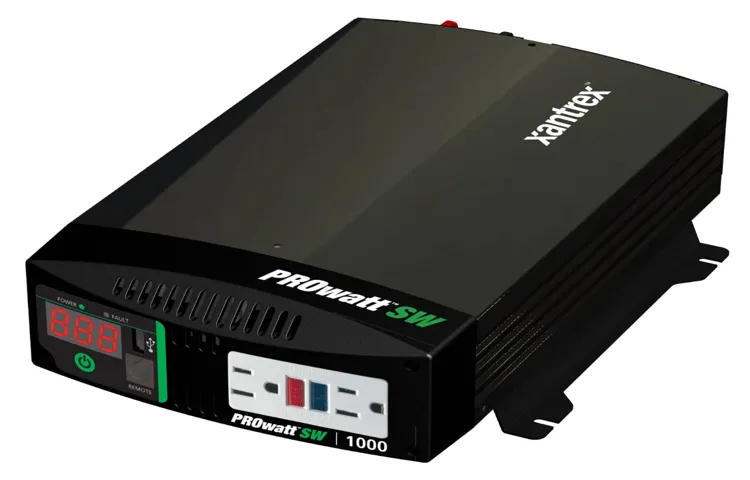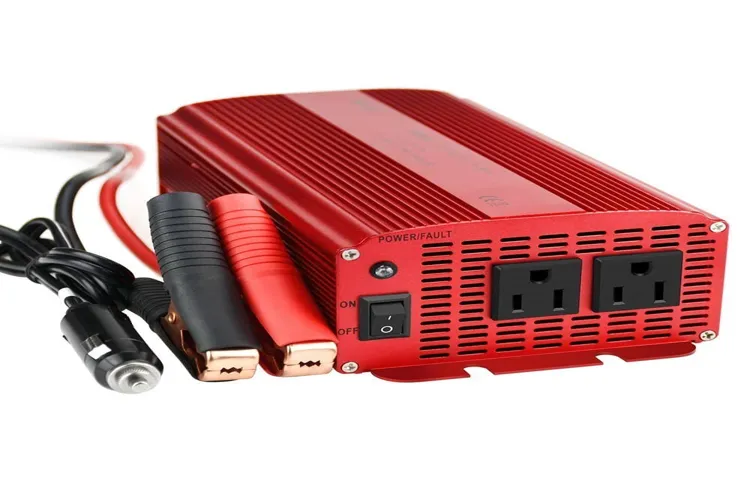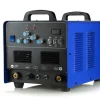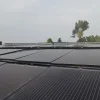Are you wondering how much power your inverter consumes? Understanding the power consumption of inverters is important for optimizing energy usage and controlling electricity costs. Inverters are devices that convert direct current (DC) power from sources such as solar panels or batteries into alternating current (AC) power for use in homes and businesses. They play a crucial role in the renewable energy sector, providing a means to harness and utilize clean, sustainable power.
But how much power do inverters themselves consume? It’s a common question among users. Inverters have their own power needs, which can vary depending on the type and size of the inverter. Some inverters have standby power consumption, meaning they draw a small amount of power even when not actively converting DC to AC.
Others have no-load power consumption, referring to the power they use when there is no AC load connected to them. The power consumed by inverters can have an impact on overall energy efficiency and the cost of electricity. By understanding and monitoring the power consumption of inverters, users can make informed decisions about their energy usage, identify potential energy-saving opportunities, and ultimately reduce their electricity bills.
So, how can you determine the power consumption of your inverter? There are a few ways to approach this. Firstly, you can check the specifications and technical details provided by the manufacturer. They often provide information on power consumption in the product manual or on their website.
Secondly, you can use a power meter or energy monitor to measure the actual power consumption of your inverter in real-time. This can give you a more accurate and personalized understanding of its energy requirements. In conclusion, understanding the power consumption of inverters is essential for optimizing energy usage and controlling electricity costs.
By knowing how much power inverters consume, users can make informed decisions about their energy usage and identify opportunities to reduce consumption and save on their electricity bills. Whether you rely on the manufacturer’s specifications or use a power meter to measure real-time consumption, being aware of your inverter’s power needs is a step towards a more efficient and cost-effective energy system. So, next time you’re using an inverter, remember to consider its power consumption and take steps to make your energy usage as efficient as possible.
Table of Contents
What is an Inverter?
When it comes to using an inverter, understanding how much power it actually uses is important. The power usage of an inverter depends on a few factors, such as the size and capacity of the inverter and the amount of power it is delivering at any given time. Inverters are designed to convert DC power from a battery or solar panel into AC power that can be used to power electronic devices.
While inverters themselves do consume some power, it is typically very minimal compared to the power that they are delivering. Think of it like a water pump – while it does require some power to operate, the majority of the power is being used by the water that is being pumped. Similarly, most of the power consumed when using an inverter is used by the devices that are being powered, rather than the inverter itself.
So, while inverters do use some power, it is generally a small amount compared to the power they are delivering.
An explanation of what an inverter is and how it works
inverter, convert, DC power, AC power, electrical current, power outage, backup power, appliances, solar panels, battery, electricity grid, reversing switch, oscillator circuit, transformer, electrical loads, power fluctuations, voltage regulation An inverter is a device that converts direct current (DC) power into alternating current (AC) power. In simple terms, it takes the electrical current from a battery or a DC power source and converts it into a form that can be used to power appliances and electrical devices that normally run on AC power. Now, you might be wondering why we need inverters in the first place.
Well, think about it this way: what would happen if there was a power outage and you didn’t have any backup power? Your appliances and electrical devices would be useless, right? That’s where inverters come in. They provide a solution for situations like these by allowing you to use battery power or power generated from sources like solar panels to run your appliances. So, how does an inverter actually work? At its core, an inverter consists of a reversing switch, an oscillator circuit, and a transformer.
The reversing switch is responsible for changing the direction of the electrical current, while the oscillator circuit generates a high-frequency AC signal. The transformer then steps up the voltage of the AC signal to a level that is suitable for powering electrical loads. One of the key functions of an inverter is to regulate the voltage of the AC power it generates.
This is important because electrical devices and appliances often require a specific voltage to operate efficiently. Without voltage regulation, power fluctuations can occur, which can result in damage to the devices or appliances. In conclusion, an inverter is a vital component that allows us to convert DC power into AC power, providing us with backup power during a power outage or enabling us to utilize alternative sources of energy like solar power.
By understanding how inverters work and their role in voltage regulation, we can appreciate the importance of these devices in our daily lives.

Why inverters are used
Inverters are essential devices that are commonly used in a variety of electronic applications. But let’s start with the basics – what exactly is an inverter? Well, simply put, an inverter is a device that converts direct current (DC) power into alternating current (AC) power. So, why would we need to convert DC power into AC power? The answer lies in the fact that most of our electrical appliances and devices are designed to run on AC power.
Think about your home – your lights, television, refrigerator, and other electronics all rely on AC power to function. Inverters are used to make sure that the DC power supply from sources such as batteries, solar panels, or car alternators can be transformed into the AC power that these devices require. So in short, inverters are the facilitators that allow our electronics to operate efficiently and effectively.
Power Consumption of Inverters
Have you ever wondered how much power an inverter uses? Well, the power consumption of inverters can vary depending on their size and load. In general, inverters are quite efficient, with some models boasting efficiencies as high as 95%. This means that only a small percentage of the power that goes into the inverter is lost as heat.
However, it’s important to note that the power consumption of an inverter will increase as the load it is powering increases. So, if you have a large load connected to your inverter, such as a refrigerator or air conditioner, it will use more power than if you were just running a small electronic device. So, when considering the power consumption of an inverter, it’s important to take into account not only the efficiency of the inverter itself but also the size of the load it will be powering.
Different types of inverters and their power consumption
Inverters are electronic devices that convert direct current (DC) into alternating current (AC), making it possible to use DC power sources, such as batteries or solar panels, to power AC electrical devices. There are different types of inverters available in the market, with varying power consumption levels. Microinverters, for example, are small inverters installed directly on individual solar panels and consume a small amount of power.
On the other hand, string inverters are larger and more powerful, capable of handling multiple panels, but they tend to consume more power. In terms of power consumption, it is important to consider the efficiency rating of the inverter. Higher efficiency inverters consume less power and therefore are more energy-efficient.
It is also worth noting that standby power consumption can be a factor to consider. Some inverters have a higher standby power consumption, which means that they continue to consume power even when not actively converting DC to AC. Overall, when choosing an inverter, it is important to consider the power consumption and efficiency rating to make sure it aligns with your energy needs and goals.
Factors that affect power consumption
inverter power consumption
Measuring power consumption of an inverter
Power consumption of inverters
Calculating Power Usage
If you’re wondering how much power an inverter uses, you’re not alone. Many people are curious about the energy consumption of these devices. Inverters are commonly used to convert DC power from a battery or solar panel into AC power that can be used to power household appliances or electronic devices.
The power usage of an inverter depends on several factors, including the size and efficiency of the inverter, as well as the power draw of the appliances or devices being powered. In general, larger inverters have a higher power consumption than smaller ones. Additionally, if you’re using the inverter to power high-draw appliances like refrigerators or air conditioners, the power usage will be higher compared to powering smaller devices like laptops or smartphones.
It’s important to consider the power usage of an inverter when choosing the right size for your needs, as well as to be mindful of the energy consumption of the devices being powered.
Formula for calculating power usage
power usage, calculating power usage, formula for calculating power usage
Calculating power usage for specific devices
Calculating Power Usage for Specific Devices If you’ve ever wondered how much power your electronic devices are consuming, you’re not alone. Understanding the power usage of specific devices can help you make informed decisions about energy conservation and reduce your electricity bills. Calculating power usage is a relatively simple process that involves a few key factors.
First, you need to know the wattage of the device. This information is usually found on a label or in the user manual. Next, you need to know how many hours the device is in use per day.
Finally, you can calculate the power usage by multiplying the wattage by the hours of use. For example, if you have a device with a wattage of 100 and you use it for 5 hours per day, the power usage would be 500 watt-hours. By understanding the power usage of your devices, you can make informed decisions about energy consumption and potentially reduce your environmental impact.
Choosing an Efficient Inverter
When it comes to choosing an efficient inverter, one important factor to consider is how much power it uses. Inverters are devices that convert DC power from a battery into AC power that can be used to run electrical appliances. The power consumption of an inverter depends on several factors, such as its size, capacity, and efficiency rating.
The size of an inverter refers to its power output capacity and is usually expressed in watts. The capacity of an inverter determines how much power it can deliver at any given time. Efficiency rating indicates how efficiently the inverter converts DC power into AC power.
Higher efficiency ratings mean that the inverter uses less power and wastes less energy in the conversion process. So, if you’re looking for an efficient inverter, make sure to choose one with a high efficiency rating and the right size and capacity for your needs.
Factors to consider when choosing an inverter based on power consumption
When it comes to choosing an inverter based on power consumption, there are several factors to consider. One of the most important factors is the efficiency of the inverter. An efficient inverter will convert DC power into AC power with minimal energy loss, resulting in lower electricity bills.
Look for inverters that have a high conversion efficiency rating, such as 95% or higher. Another factor to consider is the power rating of the inverter. Make sure to choose an inverter that can handle the power requirements of your appliances and devices.
For example, if you have a refrigerator that requires 500 watts of power, choose an inverter with a power rating of at least 600 watts to ensure it can handle the load. Additionally, consider the surge capacity of the inverter. Surge capacity is the ability of the inverter to handle brief periods of high power demand, such as when starting up an appliance.
Having a higher surge capacity can prevent the inverter from overloading and potentially damaging your appliances. So, when choosing an inverter based on power consumption, make sure to consider its efficiency, power rating, and surge capacity to ensure it meets your needs.
Inverter efficiency ratings
inverter efficiency ratings, choosing an efficient inverter
Cost vs efficiency considerations
inverter, efficiency, cost, choosing When it comes to choosing an inverter for your solar power system, it’s important to consider both cost and efficiency. While you may be tempted to go for the cheapest option, it’s crucial to remember that an inefficient inverter can end up costing you more in the long run. An inefficient inverter will convert less of the electricity generated by your solar panels into usable power for your home, resulting in higher electricity bills.
On the other hand, investing in an efficient inverter may have a higher upfront cost, but it will pay off in the long term by maximizing the electricity generated by your solar panels. So, how do you choose an efficient inverter without breaking the bank? Consider factors such as the inverter’s efficiency rating, warranty, and reliability. It’s also a good idea to consult with a professional solar installer who can guide you in selecting the most cost-effective and efficient inverter for your specific needs.
Remember, finding the right balance between cost and efficiency is key to getting the most out of your solar power system.
Tips for Reducing Inverter Power Consumption
How much power does an inverter use?” is a common question among those who are concerned about reducing their energy consumption and saving on their electricity bills. When it comes to inverters, power consumption can vary depending on several factors. The size and capacity of the inverter, as well as the type of appliances connected to it, can all impact its power usage.
In general, however, modern inverters are designed to be efficient and minimize power loss. One way to reduce inverter power consumption is to choose an inverter that matches the capacity of your appliances. Using an oversized inverter can lead to unnecessary power wastage.
Additionally, opting for energy-efficient appliances can make a significant difference in reducing power consumption. It’s also important to regularly maintain and clean your inverter to ensure optimal performance. By following these tips, you can effectively lower the power consumption of your inverter and save energy in the process.
Practical tips for minimizing power usage
Tips for Reducing Inverter Power Consumption When it comes to using inverters, finding ways to minimize power usage can help not only in reducing your energy bill but also in contributing to a more sustainable environment. One practical tip for reducing inverter power consumption is to choose an inverter with a higher efficiency rating. Inverters with higher efficiency ratings can convert more of the DC power from the battery into AC power, resulting in less power loss.
This means that you will be able to power your appliances more efficiently, ultimately reducing the amount of power needed from the battery. Another tip is to properly size your inverter. Choosing an inverter that is just the right size for your needs can help in minimizing power consumption.
If you choose an inverter that is too large for your needs, it may consume more power than necessary. On the other hand, if you choose an inverter that is too small, it may need to work harder to meet the power demands, resulting in increased power consumption. Regular maintenance of your inverter can also help in reducing power usage.
Keeping your inverter clean and free from dust and debris can ensure that it operates at its optimum efficiency. Furthermore, checking for any loose connections or wiring issues can help identify and resolve any potential power loss. In addition to these tips, it is also important to consider the devices that are connected to the inverter.
Appliances that are energy-efficient can help in reducing overall power consumption. Choosing Energy Star-rated appliances and LED lights can go a long way in minimizing the power usage of your inverter. By implementing these practical tips for reducing inverter power consumption, you can not only save on your energy bill but also do your part in conserving energy and protecting the environment.
Remember, every small step counts when it comes to sustainability, and optimizing your inverter power usage is a great place to start.
Alternative power sources and their impact on inverter power consumption
inverter power consumption, alternative power sources
Conclusion
In conclusion, the power consumption of an inverter can be as elusive as a magician’s disappearing act. Just when you think you’ve got it figured out, it slides through your fingers like a slippery eel. It’s like trying to catch a glimpse of a UFO in the night sky – it’s there one moment, and gone the next.
But fear not, dear reader, for I have come to shed some light on this enigma. Think of an inverter as a clandestine vampire, silently sucking the energy from your battery to power its wicked endeavors. Just like Dracula sneaking in the night, it may seem like it’s not doing much, but make no mistake, it’s busy consuming power behind the scenes.
To truly understand the power usage of an inverter, one must embark on a journey of discovery, much like Indiana Jones in search of hidden treasure. Armed with a trusty energy meter, we venture forth into the unknown, unravelling the mystery one watt at a time. As we delve deeper into the inverter’s power consumption, we find that it’s a bit of a shape-shifter.
It can adapt its power usage depending on the load it’s driving, just like a superhero changing costumes to suit the occasion. When faced with small devices like phone chargers, it may sip power like a dainty tea party, but hook it up to a power-hungry beast like a refrigerator, and it will roar to life like a thunderous electrical storm. So, my fellow knowledge seekers, the power usage of an inverter is not a fixed number etched in stone, but rather a fluctuating dance of energy that twirls with the whims of connected devices.
It’s a riddle wrapped in an enigma, sprinkled with a dash of “how the heck does this work?” In the end, the true power consumption of an inverter is not just about the numbers on the energy meter, but the magic it performs. It takes the raw power from a battery and transforms it into a symphony of electrical energy, breathing life into our gadgets and appliances. So, the next time you flip that switch on your inverter, take a moment to appreciate the hidden complexities and the power play happening behind the scenes.
Summary of key points discussed in the blog post
“Tips for Reducing Inverter Power Consumption” Inverters are an essential component of many electronic devices, converting DC power to AC power. However, they can also consume a significant amount of power themselves. If you’re looking to reduce your energy consumption and save on your electricity bill, here are some tips for minimizing the power consumption of your inverter.
Firstly, consider the efficiency rating of your inverter. Higher-rated inverters are generally more efficient, meaning they waste less power in the conversion process. Investing in a high-quality inverter with a high efficiency rating can help reduce power consumption.
Secondly, consider the power requirements of the devices you are powering with your inverter. If you have devices that require a lower AC voltage, using a lower voltage inverter can help reduce power consumption. Additionally, using energy-efficient devices and appliances can also contribute to overall power savings.
Another tip for reducing inverter power consumption is to minimize the length of the DC cables connecting the battery to the inverter. Longer cables can result in higher power losses, so keeping the cables as short as possible can help minimize these losses. Furthermore, avoiding overloading the inverter can also help reduce power consumption.
If you’re not using a device, make sure to turn it off or unplug it from the inverter. Running unnecessary devices can consume unnecessary power. Lastly, regularly maintaining and servicing your inverter can help optimize its performance and reduce power consumption.
Cleaning the components and ensuring they are functioning properly can help prevent any unnecessary power wastage. Reducing inverter power consumption can contribute to overall energy savings and help you reduce your electricity bill. By following these tips and being mindful of your energy usage, you can maximize the efficiency of your inverter and minimize energy waste.
FAQs
How much power does an inverter use?
The power usage of an inverter depends on its size and efficiency. Generally, smaller inverters with a capacity of 300-500 watts consume around 15-30 watts of power when idle and up to 90% efficiency when converting DC to AC power. Larger inverters with a capacity of 1000-5000 watts may have idle power consumption between 30-60 watts and achieve similar efficiency.
Does the power consumption of an inverter vary with different loads?
Yes, the power consumption of an inverter varies with the loads connected to it. As the load increases, the power draw from the inverter also increases. However, modern inverters are designed to optimize power consumption based on the load, so they remain efficient even with varying loads.
Can I calculate the power usage of an inverter based on the connected appliances?
Yes, you can estimate the power usage of an inverter by adding up the power ratings of the appliances connected to it. Ensure you convert all power ratings to the same unit (Watts or kilowatts) and consider their running time to calculate the energy consumption in kilowatt-hours.
What factors affect the efficiency of an inverter?
Several factors can affect the efficiency of an inverter, including its size, quality, and design. In general, larger inverters tend to have higher efficiencies. Additionally, inverters with better circuitry and components are more efficient. The quality of DC-to-AC conversion and the overall design play a crucial role in determining an inverter’s efficiency as well.
Can an inverter drain power when not in use?
Yes, some inverters may have a small idle power consumption even when not in use. This is because they need to remain operational and ready to convert power whenever necessary. However, modern inverters often have standby or power-saving modes to minimize idle power consumption.
Are inverters more efficient with specific appliances?
Inverters are designed to work with a wide range of appliances, but they may be more efficient with certain types. In general, inverters are most efficient when used with appliances that have a power factor close to 1. Inductive loads, such as motors or refrigerators, might slightly reduce an inverter’s efficiency compared to resistive loads like heaters or lights.
Can a high-capacity inverter consume more power than necessary?
Yes, using an inverter with a much higher capacity than required can lead to inefficiencies and higher power consumption. It is recommended to choose an inverter that matches the power requirements of the connected appliances for optimal efficiency and power usage.



